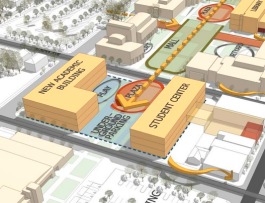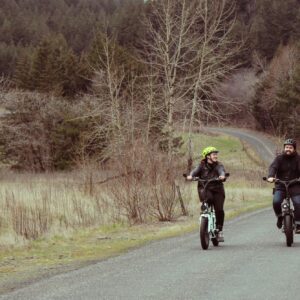
lot. The street on the lower right is
N. Killingsworth.
Back in October we shared the news that Portland Community College’s Cascade campus was planning to build a $9 million, four-story parking garage at the corner of N. Michigan and Killingsworth. Now there’s a new option on the table: an underground lot that would be built below existing campus buildings on N Jessup between Mississippi and Albina.
There was significant concern with the multi-level parking garage from some stakeholders not only because of its cost (about $30,000 per slot for an estimated 300 spaces) and fears of inducing auto travel demand, but also due to how the building would impact the streetscape of Killingsworth and the future neighborhood greenway slated for Michigan Ave.
According to the planning firm working with PCC on the project, the underground lot would save the school $1.5 million in construction costs over the above-ground lot; but it would also fit 60 fewer cars (PCC is building the garage thanks to a $374 million bond measure passed by voters in 2008). With auto parking demand already the key factor driving this project, a reduction in capacity is a concern for the College.
According to Bond Advisory Committee meeting notes, a “large majority” of stakeholders support the underground parking garage. The new plans were unveiled earlier this month and PCC published a blog post about it yesterday.
But with parking demand already at a premium, the 60 fewer cars the underground garage would fit means that in order to move forward with it, PCC says they would have to feel confident that a plan to reduce car trips would be successful. In tandem with construction plans, PCC is working on a large-scale transportation demand management (TDM) plan with a goal of increasing the rate of biking and taking transit to the campus (it is just a few blocks from a MAX line and adjacent to a frequent service bus line).
The PCC Bond Program’s Public Involvement/Stakeholder Engagement Manager Gina Whitehill-Baziuk told the advisory committee on December 5th that,
“the proposed underground lot would only work if the College and its external partners can effectively collaborate to meet the TDM targets… If the College finds that it would not be able to meet those targets, the original Option A3 with the proposed four-story garage would need to be reconsidered.”
Of all four of PCC’s main campuses, the Cascade campus in North Portland has the most potential for shifts in travel behavior. A travel preference survey of over 4,800 students, faculty and staff last May showed that 26% of respondents either bike (10%), walk (3%) or take transit (13%) to the campus.
Students seem up to the challenge.
Doug Taylor, President of Associated Students of PCC, said there’s “near universal support” for the underground lot. “It would be embarrassing if the tallest building on campus was a parking structure,” he said during the advisory committee meeting. When reminded by a PCC staff member that the underground lot would mean “students have to get out of their cars and use other options,” Taylor sounded optimistic that behaviors could change. He said bike storage facilities on and around campus would help people bike more and he also mentioned a new program set to start this winter that will refurbish used bikes and lease them out to students for $75 a term.
PCC says they’ll make a final decision on the parking lot by the end of this year. If you have a comment you’d like to share with them, please leave it below and I’ll make sure to pass it along (they don’t seem to have a general public feedback email).




What if they spent the “extra” $1.5mill on a bad-ass bike locker facility?
Great idea. Indoor bike parking, showers, stands/ tools. They could ask the Bike Hub at PSU for some tips, or the builders of the new complex in Eugene. They could also get all of the students free transit passes.
Sweet. That would serve 13%. The other 87% can suck it.
The TDM aspects of this issue warrant emphasis, but the cost figures don’t seem quite right in the story.
Underground parking typically runs 1.5 to 2 times the cost of above-ground parking. I suspect that putting the parking underground isn’t what saves PCC money, it’s building fewer spaces.
Besides the TDM program, PCC ought to charge parking rates that will assure full cost recovery. Proper pricing may drive demand even lower, maybe allowing them to build an even smaller parking facillity.
The apparent savings probably comes from the fact that the underground garage will be incorporated into the other new buildings, rather than constructed as a stand-alone facility, and they probably didn’t include costs that would have been incurred to build only the buildings without the underground garage.
Thanks, I was scratching my head over this. I’ve read that underground parking costs about $50,000 per space, versus $25,000 for an above-ground structure. But in this case underground is about the same cost ($1.5 million / 60 = $25,000 per space).
At the same cost, underground is a huge improvement. It will save land, which could later be used for other purposes, so this is actually even cheaper than it looks.
Parking costs need to be thought of carefully. If parking costs are too great on PCC lots and garages, it will spill out even further into the neighborhood. Yes, there could be a street parking program to try to prohibit students from parking in the neighborhood, but the issue is always who pays for such a program.
For a few million they could expand bike share all the way north from the Rose Quarter to the PCC campus & if you removed a lane of parking there’d be room for a protected two way cycle on Killingsworth from the max stop to the campus. Might even get the drug dealers to move off the campus. Seems like a better use of money than this parking garage.
13% transit?!? Yikes.
The University of Washington consistently hovers at around 40% transit for students and staff (faculty around 25%), and it’s not by accident. We have an excellent TDM tool in the U-PASS program that provides unlimited transit upon purchase, and a student initiative recently changed the U-PASS program from opt-in to “universal” for students starting this fall quarter. What did this do for students? Only supply unlimited transit to all students at a two-year fixed rate of $76/quarter. Comparing that with PCC’s website, I see, “PCC will sell a limited number of these [Winter Term all-zone passes] for $160 on a first come, first serve basis.”
Really?!?
Even when our U-PASS program was opt-in our unlimited transit option was more cost-effective than the PCC version. With the new universal program we’re offering students essentially the same product at less than HALF the PCC cost. And our program was never limited to “first come, first serve.”
It seems odd to me that PCC is spending so much time, energy, and $ pursuing a parking garage when there’s such obvious room for improvement on the TDM front.
What is transit percentage for PSU? Build a reliable regular bus system to serve PCC Cascade as well.
We will have to use underground space if we want to have a dense urban core; it’s simple math.
The not so simple math is the prioritization of underground vs surface use priority.
I would not underestimate the futility of trying to under-prioritize pedestrian use of traditional surface paths and roads.
Cars and trucks can go underground. Truth be known as a former trucker I kinda like the idea of a freight dock isolated from not just weather but idiot drivers too.
I honestly question why they are building any parking at all. Is a new parking garage really going to boost enrollment that much? I doubt it.
With increased population growth in North Portland, Killingsworth has a chance to become a vibrant street. A parking garage would be a step backward.
Justin-
This is not about increasing enrollment. This is about the current enrollment already being too much for the infrastructure.
The easiest solution would be to cap enrollment and limit the amount of classes offered at any point during the day. Of course this too would have reprecussions.
Hey Jonathan, there’s a small error in your story; You say this underground lot would be “built below existing campus buildings,” however this is incorrect. The proposed site is currently a surface parking lot and green-space, so the underground parking would be below -future- buildings.
The garage needs to go underground. We do not need a big parking structure along Killingsworth. The area has potential to be developed as a pedestrian and bike friendly neighborhod, and installing a large above ground parking facility will present an obstacle to this goal.
How are they going to keep the gang bangers out of the garage? Is this a place where you would feel comfortable going at night?
I agree with those who question the need for more parking, even underground. If these spaces are going to cost about $25,000 each (as calculated from 1.5 mil / 60), then each parking space will cost more than the car parked in it! They would need to charge at least $10 a day for parking, or $2500 a year, to use the garage, just to pay for financing and depreciation costs. Does the market support such a cost for parking in this neighborhood?
Why not charge find out? Start charging $10 a day to park at PCC, institute a residential permit program in the surrounding streets, and see how the drive/transit/bike/walk ratio changes.
Joseph-
PCC does charge to park (not $10/day). And there is a residential permit in the surrounding neighborhood. Tickets for non-compliance are not cheap.
The residents around the campus already have parking permits. Off-campus parking by students is forbidden from Ainsworth to Alberta and Albina to Vancouver. The campus sells parking permits term-by-term, but I don’t know the cost because I don’t own a car. I do know that I very rarely see open spaces but frequently see students running several blocks to get to class on time.
the folks who go to PCC are commuters by definition, and are also not landed gentry who can afford high dollar parking. it seems pretty rough to suggest they should all move to the immediate neighborhood and walk; or bike/bus from wherever they may reside (ie, not local). sometimes cars are necessary and useful
i’m all about promoting biking, but please have a little sympathy for the folks who are going to school to improve their job prospects. we should be encouraging/supporting them
i see good things happening on this project. they are improving the parking situation for local residents and businesses by getting it OFF-STREET. Additionally they are spending more to put it underground (i do NOT believe it is cheaper [i’ve worked on similar projects before]); the benefit is more livable sidewalks and streets for pedestrians.
ac makes very important points in the first two paragraphs. Attending PCC does not mean that all of one’s classes are at one campus. I was enrolled in a program that in more than one term had me taking two night classes at different campuses: Sylvania and Cascade. I lived in SE at the time. I had the luxury and fitness to be able to ride to class. Also, I love riding in the rain and cold but many do not.
The PCC demographic is different than PSU. Many of my fellow students had kids and all of them worked full time – some downtown and some in the outer reaches. They ranged in age from 20 to 45. There may have been a couple who could have road their bike to one of the campuses (maybe 3 or 5 miles).
Improved bus service would help greatly but remember that connections can be difficult. I think this parking facility serves a good purpose and lessens the impact of on-street parking on local residents.
As a one time student and current neighbor, might I suggest they explore increased shuttle service? The shuttles are very popular, hold 3 bikes, and Cascade is pretty far from central and southwest Portland for a lot of people. PCC used to run a shuttle directly from PSU to Cascade that was discontinued at the height of its popularity. If Cascade is considering at all how to reduce cars on campus, I can’t understand why they’re not running a shuttle from the central city to Cascade.
I’d also agree with suggestions that secure bike parking be installed. My impression is that theft can be pretty bad there.
Does anybody not have a concern for safety and security with an underground facility? Whether on my bike or in my car, I have no interest is traveling underground. If I need help or assistance, I want to be where my horn or my voice might be heard by someone walking by on the sidewalk, not muffled from all passersby.
As a cyclist, if I had a choice to cross a freeway on a dry, well-lit underground tunnel or an above-ground exposed-to-the-elements bridge, I’d take the bridge any time. Bad things happen when bad people know nobody is looking.
I definitely would support the underground garage and continuing to explore TDM plan options to increase non-auto commuting. The TDM plan certainly has to consider that the PCC student body has different needs than PSU or a residential school like Reed, but still, there are options.
Just a fact check, people keep throwing around the $1.5 million for 60 spaces figure, but that’s not the right math. The actual cost for each underground space is ($9 million for the above ground facility minus the $1.5 million savings) divided by (approximately 300 spaces minus 60 spaces), or $37,500 per space, which is more in line with average underground parking costs that I have heard.
And along the lines of what makes the PCC student body different from students at other schools, I’m always intrigued and saddened by the argument that poor people need their cars and don’t have time and resources for bikes and transit. (For example, see ac’s suggestion that PCC students aren’t “landed gentry” so cars are “necessary and useful” for them.) If society really cares about helping those with fewer resources, shouldn’t we be finding ways for people to get around without cars so they don’t have to invest so much in their vehicles?
nice parsing for your argument’s convenience
not what i said, and i’m guessing you knew it
Well said everyone.
Please call the PCC bond program 971-722-8410
http://bond.pcc.edu/contact-us
talking points:
– A better and independent survey needs to be done of students and staff who can and could drive less.
– Free tri-met passes for students.
– Invite a campus president or bond leader to join you in taking a bus, bike or walk to work.
– PCC shuttles need proper independent management by people who ride, bus or bike to work, not the manager of parking. The shuttle routes and drop off spots are highly inefficient. Lack of capacity and poor design pushes people to drive.
– Bond money does not come out of the PCC pocket, but bond money does fill the pockets with gold. The permit system can be better designed for people with disabilities or hardships and reward people who want to drive less. Parking permits are a huge cash cow for PCC.
– PCC needs a TDM committee with a majority of members who use bus, bike or walking at least 50% of the time.
– PCC should survey voters and ask them if they would vote for another bond knowing the last bond spent millions to build parking spaces at 25k per space. Things seem quiet now, but the media will run with this story once the garage is built.
– PCC should be a model of sustainability and embrace criticisms.
– Join other activists. Click the join us links on
http://www.activerightofway.org/
Facebook, Google Groups, Twitter, etc